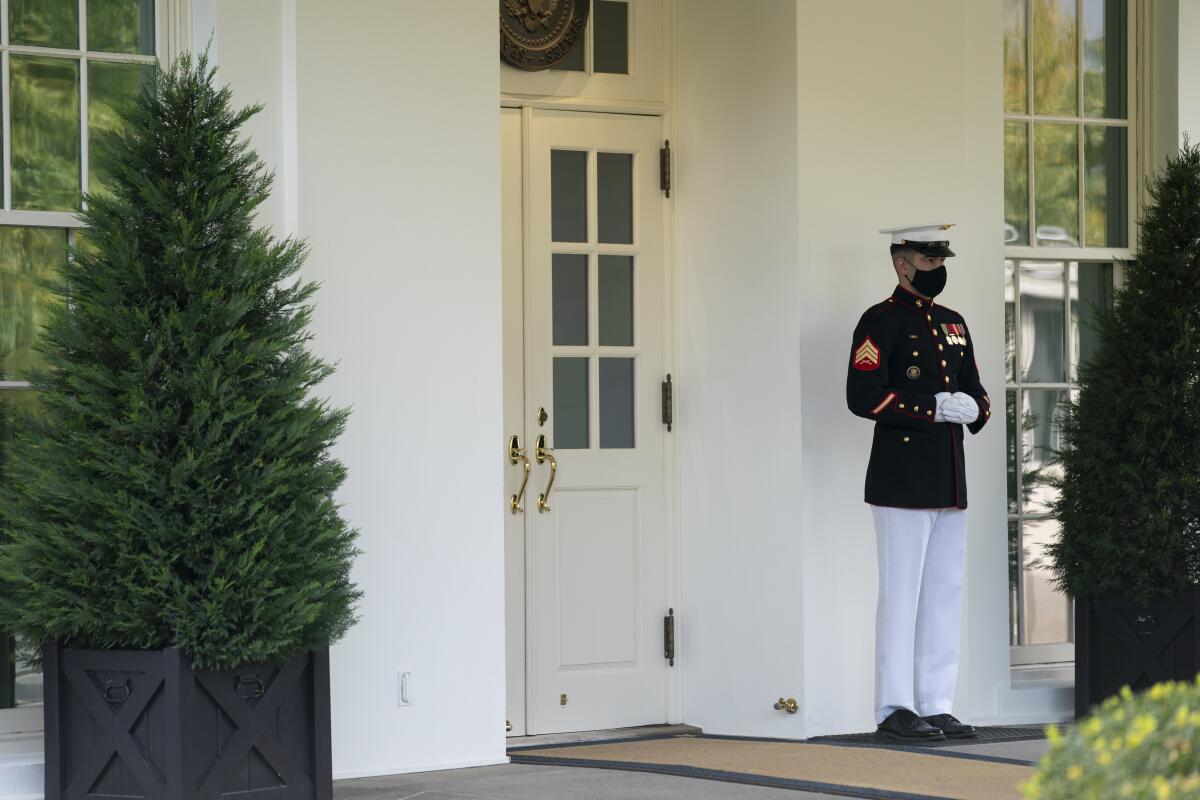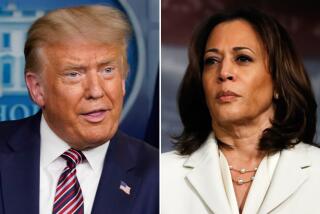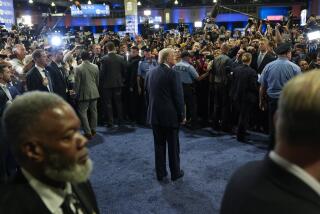One debate is scrubbed, another is confirmed, as Trump resumes campaign travel

- Share via
WASHINGTON — After two days of confusion, the bipartisan group that organizes presidential debates said Friday that it had canceled the scheduled face-off next week between President Trump and former Vice President Joe Biden, but that it expects them to debate once more before the election.
Barring any last-minute snags, the second and final presidential debate will take place Oct. 22 in Nashville. Like the first, it will be a face-to-face exchange on a stage, and not a virtual town-hall style event, as the commission had proposed for the now-canceled debate.
The Commission on Presidential Debates announced the decision Friday hours after Trump, who was hospitalized for COVID-19 last weekend, announced plans to resume live campaign events this weekend despite continuing questions about whether he is still contagious or could be reinfected.
Eager to erase the image of a COVID-stricken patient, Trump will stand on a White House balcony Saturday and address hundreds of invited guests for what the campaign billed as a “peaceful protest for law & order.”
Attendees will be required to bring masks and “instructed” to wear them, but doing so won’t be mandatory, according to an official familiar with the planning. They will be asked about their health and have their temperatures taken, but will not be given a coronavirus test, the official said.
Trump also will host a campaign rally at an airport hangar in Sanford, Fla., on Monday, marking the president’s first travel since he was airlifted to Walter Reed National Military Medical Center on Oct. 2 with COVID-19. He was released Monday and has been confined to the White House.
The planned gatherings raised concerns about not only the president’s health, but also potential risks for his supporters, who often disdain masks and social distancing.
Numerous people who attended a crowded White House event on Sept. 26, when Trump introduced Supreme Court nominee Amy Coney Barrett, have since tested positive for the virus.
Dr. Anthony Fauci, the nation’s top infectious disease authority, labeled that assembly a “super-spreader event in the White House” Friday in a CBS News Radio interview.
The White House has refused to say when Trump last tested negative for coronavirus, and the president said Friday night in a Fox News interview that he did not know the results of his tests. The claim seemed implausible given White House testing facilities and access to top laboratories.
He then added, cryptically, that he was “either at the bottom of the scale or free,” which is not how coronavirus tests results typically are reported.
Trump also said he was no longer taking the steroid dexamethasone, which makes some patients behave erratically.
On Thursday, Trump’s physician, Dr. Sean Conley, said that Trump appeared on track to be able to safely return to public life Saturday. That was a shift from several days earlier, when Conley said the president would need to stay in isolation until at least Monday. He did not explain why he moved up the timeline.
The White House has said nothing about First Lady Melania Trump’s health since she tested positive for the coronavirus last week and tweeted that she had mild symptoms.
Her chief of staff, Stephanie Grisham, did not respond Friday to questions about her recovery, saying in an email only, “She’s doing well.”
The debate dispute erupted on Thursday when the commission, concerned about Trump’s infection, said that the Oct. 15 town-hall-style debate would be virtual, with the two candidates speaking from separate locations.
Trump swiftly refused, saying he couldn’t debate that way.
Both candidates said they would still debate on Oct. 22, but Trump’s campaign insisted on a third debate a week later, or five days before the election. Biden rejected that, and the commission agreed.
The decision is a blow to Trump, who is sagging in the polls and eager to recover from an ugly performance in his first debate, which saw voters shift even more toward Biden.
Though he has not left the White House, Trump spent the last two days on a media blitz: giving interviews to friendly TV and radio anchors, dropping the F-bomb and complaining that even his longtime supporters in the media don’t treat him fairly anymore.
Since taking office, Trump has relied on calls to credulous Fox News hosts and Rush Limbaugh, where he got unstinting support and preached mostly to his base. But now, he is trying to resuscitate his flagging reelection campaign and infected body on live television.
Trump called in to a “virtual rally” on Limbaugh’s radio show for two hours Friday, then spoke on Mark Levin’s talk show, and later let a Fox contributor, Dr. Marc Siegel, question him from afar in a faux medical exam on Tucker Carlson’s prime-time show.
The interview with Siegel, his first on camera, yielded little new information about Trump’s condition.
The Fox News blitz — Trump also did two one-hour calls to Fox hosts Thursday and plans another Sunday — underscores how his close media ties have enabled him to remain in an information bubble, where even his most outlandish claims are taken seriously and sometimes promoted.
At least in his radio and TV interviews, Trump reverted to form — lashing out at not only his political opponents, but also some of his closest aides, in disjointed tirades based on conspiracy theories.
At one point, Trump falsely accused Virginia Gov. Ralph Northam, a Democrat, of executing a baby. He also vilified Sen. Kamala Harris of California, the Democratic nominee for vice president and the first Asian American and Black woman on a national ticket, as a “monster.”
But Trump also raged against two of his most loyal Cabinet officers, Atty. Gen. William Barr and Secretary of State Michael R. Pompeo.
Even as Fox gave Trump a daylong soapbox 25 days before the election, he groused to Limbaugh that Fox was “no longer the same” since Roger Ailes, the network’s founder, died in 2017.
Changes at Fox were “the biggest difference” for his campaign, compared with 2016, Trump declared, not acknowledging the role of the pandemic that has killed 213,000 Americans this year. He then ticked through a list of the Fox anchors he liked and disliked.
After Limbaugh began his broadcast by playing “God Bless the U.S.A.,” Trump’s rally walk-up music, and a recording of rallygoers chanting, “We love you,” Trump reprised his hyperbolic boasts and grievances against Democrats and most other media.
“They don’t cover any good stuff with me,” the president complained.
When the topic turned to Iran, Trump used a profanity and warned Tehran not to cause trouble or the U.S. would “do things to you that have never been done before.” The obscenity was not played on Limbaugh’s syndicated radio show but was heard online by his paid subscribers.
More to Read
Get the L.A. Times Politics newsletter
Deeply reported insights into legislation, politics and policy from Sacramento, Washington and beyond. In your inbox twice per week.
You may occasionally receive promotional content from the Los Angeles Times.












